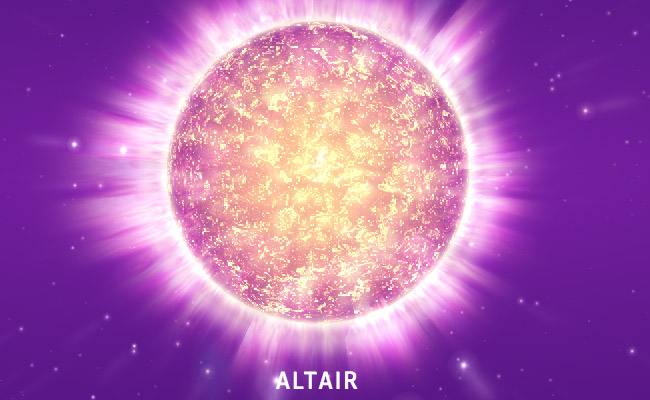Altair – Star Facts

Altair is located approximately 16.8 light-years from the Earth in the constellation of Aquila. It is the 22nd constellation in size out of the eighty-eight and has two meteor showers (the June Aquilids and the Epsilon Aquilids ). Aquila also belongs to the Hercules family of constellations.
Observation
Altair (Alpha Aquilae) can be seen in its home constellation located in the fourth quadrant of the Northern hemisphere, specifically between latitudes of +90 and -75 degrees. Because this star is one of the closest to Earth, it can be viewed by the naked eye. The best time to view this star is in the summer to autumn months when it rises about 90 minutes after sunset. However, by September’s end, Altair will approach the meridian as night falls and by the end of the year it disappears less than three hours after the sun sets. When locating Altair in the night sky it can also be viewed easily in part of the Summer Triangle; Alpha Aquilae is the southernmost star in this trio.
Star Characteristics and Features
Altair is an A-type main sequence star with 1.8 times the mass of the Sun. It is also a rapid rotator completing a rotation on its axis every nine hours (the Sun takes 25 days). Because of this fast spinning motion, Alpha Aquilae is oblate in shape, meaning its equator is about 20 percent larger in diameter than its polar regions.

Brightness of the Star
Alpha Aquilae is the brightest star in its home constellation and also the 12th brightest in the night sky. It shines with an apparent visual magnitude of 0.77 and is estimated to be around 11 times more luminous than the Sun. In addition, studies have shown that Altair does vary in its brightness by less than a thousandth of a magnitude. For this reason it can be classified as a Delta Scuti variable star.
History and Mythology
Altair and the constellation of Aquila played a large role in some mythology. The “eagle” was said to be favoured by Zeus and was used to capture a young boy (Ganymede) to be used as a cup-bearer to the gods. The eagle also played a role in the torment of Prometheus, leading to the bird’s untimely death by a poisoned arrow from Hercules’ bow. In India, Altair and its celestial buddies are thought to be the footprints of the god, Vishnu. Aquila was catalogued in the 2nd century (along with others) by the Greek astronomer known as Ptolemy.
Altair is not just another twinkling celestial object, it has some cold hard facts and true significance. So if you have a chance to view this star of “the eagle” in the night sky be sure to check it out.
